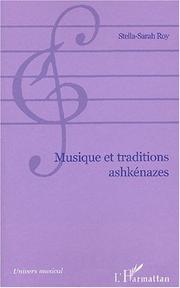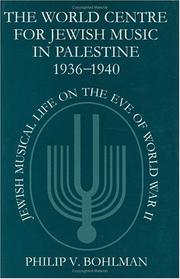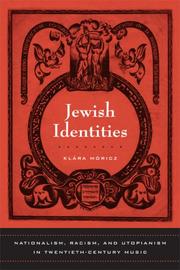| Listing 1 - 9 of 9 |
Sort by
|

ISBN: 2747531724 Year: 2002 Publisher: Paris Budapest Torino L'Harmattan
Abstract | Keywords | Export | Availability | Bookmark
 Loading...
Loading...Choose an application
- Reference Manager
- EndNote
- RefWorks (Direct export to RefWorks)

ISBN: 0198162375 Year: 1992 Publisher: Oxford, N.Y. Clarendon Press
Abstract | Keywords | Export | Availability | Bookmark
 Loading...
Loading...Choose an application
- Reference Manager
- EndNote
- RefWorks (Direct export to RefWorks)
Music --- muziekkritiek --- muziekgeschiedenis --- muziek --- joodse muziek --- Palestine --- Jews --- History and criticism --- World Centre for Jewish Music in Palestine --- 78.33.3
Book
ISBN: 9780199354948 0199354944 0199354952 9780199354962 0199354960 1322146918 9780199354955 Year: 2014 Publisher: New York, NY : Oxford University Press,
Abstract | Keywords | Export | Availability | Bookmark
 Loading...
Loading...Choose an application
- Reference Manager
- EndNote
- RefWorks (Direct export to RefWorks)
Shelleg revolutionizes the study of modern Israeli art music by tracking the surprising itineraries of Jewish art music in the move from Europe to Mandatory Palestine and Israel. Leaving behind clichés about East and West, Arab and Jew, this book provocatively exposes the legacies of European antisemitism and religious Judaism in the making of Israeli art music.
Music --- Music by Jewish composers --- Jews --- Musique --- Musique de compositeurs juifs --- Juifs --- History and criticism --- History and criticism. --- Histoire et critique --- Jewish composers' music --- Jewish music --- Music by Jews --- Musical compositions by Jews
Book
ISBN: 1487531672 1487531664 9781487531676 9781487531669 Year: 2020 Publisher: Toronto
Abstract | Keywords | Export | Availability | Bookmark
 Loading...
Loading...Choose an application
- Reference Manager
- EndNote
- RefWorks (Direct export to RefWorks)
"The orchestral conductor Heinz Unger (1895-1965) was born in Berlin, Germany and was reared from a young age to follow in his father's footsteps and become a lawyer. In 1915, he heard a Munich performance of Gustav Mahler's Das Lied von der Erde ("The Song of the Earth") conducted by Bruno Walter and thereafter devoted the rest of his life to music and particularly to the dissemination of Gustav Mahler's music"--
Conductors (Music) --- Unger, Heinz, --- Germany. --- Canada. --- Bruno Walter. --- German Jewish Identity. --- Gustav Mahler. --- Heinz Unger. --- Jewish Identity. --- Jewish Music. --- Jews in Canada. --- Munich. --- biography. --- conductors. --- history of music. --- orchestral music.
Book

ISBN: 3110750813 3110750716 Year: 2022 Publisher: Berlin/Boston De Gruyter
Abstract | Keywords | Export | Availability | Bookmark
 Loading...
Loading...Choose an application
- Reference Manager
- EndNote
- RefWorks (Direct export to RefWorks)
How was the re-emerging Jewish religious practice after 1945 shaped by traditions before the Shoah? To what extent was it influenced by new inspirations through migration and new cultural contacts? By analysing objects like prayer books, musical instruments, Torah scrolls, audio documents and prayer rooms, this volume shows how the post-war communities created new Jewish musical, architectural and artistic forms while abiding by the tradition. This peer-reviewed volume presents contributions to the conference „Jewish communities in Germany in Transition", held in July 2021, as well as the results of a related research project carried out by two university institutions and two museums: the Bet Tfila – Research Unit for Jewish Architecture (Technische Universität Braunschweig), the European Center for Jewish Music (Hanover University for Music, Drama and Media), the Braunschweigisches Landesmuseum, and the Jewish Museum Augsburg Swabia. For the first time, post war synagogues in Germany and their objects were researched on a broad and interdisciplinary basis – regarding history of architecture, art history of their furniture and ritual objects as well as liturgy and musicology. The project was funded by the Federal Ministry of Education and Research (BMBF) during the years 2018 to 2021 in its funding line „The Language of Objects".
Holocaust, Jewish (1939-1945) --- Jews --- Judaism --- Spiritual life --- HISTORY / Europe / Germany. --- Influence. --- Music. --- History --- Social life and customs --- Liturgy. --- Judaism. --- Jewish life. --- architecture. --- liturgical practice. --- museum. --- post-war Germany. --- Worship (Judaism) --- Hebrews --- Israelites --- Jewish people --- Jewry --- Judaic people --- Judaists --- Ethnology --- Religious adherents --- Semites --- Hebrew music --- Jewish music --- Music --- Music, Hebrew --- Music, Jewish --- Ritual --- Rituals

ISBN: 0520933680 9780520933682 9780520250888 0520250885 Year: 2008 Publisher: Berkeley University of California Press
Abstract | Keywords | Export | Availability | Bookmark
 Loading...
Loading...Choose an application
- Reference Manager
- EndNote
- RefWorks (Direct export to RefWorks)
Jewish Identities mounts a formidable challenge to prevailing essentialist assumptions about "Jewish music," which maintain that ethnic groups, nations, or religious communities possess an essence that must manifest itself in art created by members of that group. Klára Móricz scrutinizes concepts of Jewish identity and reorders ideas about twentieth-century "Jewish music" in three case studies: first, Russian Jewish composers of the first two decades of the twentieth century; second, the Swiss American Ernest Bloch; and third, Arnold Schoenberg. Examining these composers in the context of emerging Jewish nationalism, widespread racial theories, and utopian tendencies in modernist art and twentieth-century politics, Móricz describes a trajectory from paradigmatic nationalist techniques, through assumptions about the unintended presence of racial essences, to an abstract notion of Judaism.
Jews --- Music --- Nationalism in music. --- Nationalism and music --- National music --- History and criticism. --- History and criticism --- Bloch, Ernest --- Schoenberg, Arnold, --- Shenberg, Arnolʹd, --- Schönberg, Arnold, --- Schenberg, A. --- Shenberg, A. --- שנברג, ארנולד --- Criticism and interpretation. --- Bloch, Ernest, --- Bloch, Ernst, --- Schönberg, Arnold --- 20th century politics. --- case studies. --- classical music. --- essentialist assumptions. --- ethnic groups. --- formidable challenge. --- jewish identities. --- jewish identity. --- jewish music. --- jewish nationalism. --- modernist art. --- paradigmatic nationalist. --- racial theories. --- religious communities. --- russian jewish composer. --- swiss american. --- utopian tendencies.
Book
ISBN: 1787445046 1787446352 1580469515 Year: 2019 Publisher: Suffolk : Boydell & Brewer
Abstract | Keywords | Export | Availability | Bookmark
 Loading...
Loading...Choose an application
- Reference Manager
- EndNote
- RefWorks (Direct export to RefWorks)
A detailed and moving account of the life of Anneliese Landau, who, in Nazi Germany and later in Émigré California, fought against prejudice to do notable work in music.
National socialism and music. --- Musicologists --- Jewish women --- Jews, German --- German Jews --- Women, Jewish --- Women --- Historians, Music --- Music historians --- Musicians --- Scholars --- Music and national socialism --- Music --- Landau, Anneliese, --- Women musicologists --- Jews --- History and criticism. --- Women musicians --- Women scholars --- Landau, Anne L., --- Emigre. --- Forbidden Music. --- Gender. --- Germany. --- Higher Education. --- Holocaust. --- Jewish Culture League. --- Jewish Music. --- Kindertransport. --- Kristallnacht. --- Kulturbund. --- Los Angeles. --- Musicologist. --- Nazi Germany. --- Terezin. --- Theresienstadt. --- Women and Music.
Book
ISBN: 1789200334 Year: 2019 Publisher: New York ; Oxford : Berghahn,
Abstract | Keywords | Export | Availability | Bookmark
 Loading...
Loading...Choose an application
- Reference Manager
- EndNote
- RefWorks (Direct export to RefWorks)
"For many centuries, Germany has enjoyed a reputation as the 'land of music'. But just how was this reputation established and transformed over time, and to what extent was it produced within or outside of Germany? Through case studies that range from Bruckner to the Beatles and from symphonies to dance-club music, this volume looks at how German musicians and their audiences responded to the most significant developments of the twentieth century, including mass media, technological advances, fascism, and war on an unprecedented scale"--
Music --- National characteristics, German. --- Social aspects --- History --- History and criticism. --- German influences. --- bavaria. --- berlin. --- case studies. --- dance. --- engaging. --- europe. --- fascism. --- female musicians. --- german concert halls. --- german culture. --- german democratic republic. --- german music scene. --- german music. --- german musicians. --- german society. --- germany. --- hamburg. --- historical. --- history. --- identity. --- jewish music. --- land of music. --- live arts. --- mass media. --- modern german history. --- munich national theater. --- munich. --- musicology. --- mythology. --- nazi past. --- performing arts. --- politics. --- postwar germany. --- rock and roll. --- technological advances. --- theater. --- theatrical productions. --- wagnerism. --- war.
Book
ISBN: 0520961005 9780520961005 9780520285583 Year: 2018 Publisher: Oakland, California
Abstract | Keywords | Export | Availability | Bookmark
 Loading...
Loading...Choose an application
- Reference Manager
- EndNote
- RefWorks (Direct export to RefWorks)
Experiencing Latin American Music draws on human experience as a point of departure for musical understanding. Students explore broad topics-identity, the body, religion, and more-and relate these to Latin American musics while refining their understanding of musical concepts and cultural-historical contexts. With its brisk and engaging writing, this volume covers nearly fifty genres and provides both students and instructors with online access to audio tracks and listening guides. A detailed instructor's packet contains sample quizzes, clicker questions, and creative, classroom-tested assignments designed to encourage critical thinking and spark the imagination. Remarkably flexible, this innovative textbook empowers students from a variety of disciplines to study a subject that is increasingly relevant in today's diverse society. In addition to the instructor's packet, online resources for students include:customized Spotify playlistonline listening guidesaudio sound links to reinforce musical conceptsstimulating activities for individual and group work
Music --- Art music --- Art music, Western --- Classical music --- Musical compositions --- Musical works --- Serious music --- Western art music --- Western music (Western countries) --- History and criticism. --- Analysis, appreciation. --- Social aspects --- audio tracks. --- candombe. --- ethnic music. --- jewish music in latin america. --- latin american music listening guide. --- latin american music. --- latin american religious music. --- marimba. --- music and healing. --- music appreciation. --- music history. --- music in latin american culture. --- music instructor. --- music of santeria. --- music students. --- music studies. --- music teacher. --- music. --- musica vallenata. --- musical concepts. --- musical genres. --- organology. --- performing arts. --- samba. --- selk nam shamans. --- timbre. --- traditional latin american music.
| Listing 1 - 9 of 9 |
Sort by
|

 Search
Search Feedback
Feedback About UniCat
About UniCat  Help
Help News
News